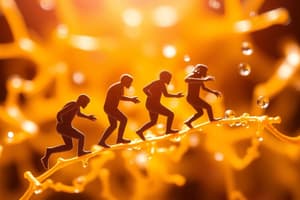Podcast
Questions and Answers
Which concept explains the structural organization of all living organisms?
Which concept explains the structural organization of all living organisms?
- Evolutionary Theory
- Cell Theory (correct)
- Gene Theory
- Homeostasis Principle
What is the main function of chlorophyll in photosynthesis?
What is the main function of chlorophyll in photosynthesis?
- To release oxygen
- To break down glucose
- To transport water
- To absorb light energy (correct)
Which branch of biology focuses specifically on heredity and variation?
Which branch of biology focuses specifically on heredity and variation?
- Ecology
- Molecular Biology
- Genetics (correct)
- Cell Biology
Which of the following correctly identifies a level of biological classification?
Which of the following correctly identifies a level of biological classification?
What is the primary outcome of cellular respiration?
What is the primary outcome of cellular respiration?
What term describes the maintenance of a stable internal environment despite external variations?
What term describes the maintenance of a stable internal environment despite external variations?
Which term best describes the process by which energy from light is converted into chemical energy?
Which term best describes the process by which energy from light is converted into chemical energy?
Which of the following statements about prokaryotic cells is true?
Which of the following statements about prokaryotic cells is true?
Which of the following roles do proteins NOT play in biological systems?
Which of the following roles do proteins NOT play in biological systems?
What is the first step of the scientific method?
What is the first step of the scientific method?
Flashcards are hidden until you start studying
Study Notes
Introduction to Biology
- Definition: The study of life and living organisms, encompassing their structure, function, growth, evolution, distribution, and taxonomy.
Branches of Biology
- Cell Biology: Study of cell structure, function, and processes.
- Molecular Biology: Focuses on the biochemical processes within cells.
- Genetics: Study of heredity and variation in organisms.
- Evolutionary Biology: Examines the origins and changes in biodiversity over time.
- Ecology: Study of organisms and their interactions with the environment.
- Botany: Study of plants.
- Zoology: Study of animals.
Fundamental Concepts
-
Cell Theory:
- All living things are made up of cells.
- The cell is the basic unit of life.
- All cells arise from pre-existing cells.
-
Theory of Evolution:
- Proposed by Charles Darwin.
- Explains how species change over time through natural selection.
-
Genetic Information:
- DNA (deoxyribonucleic acid) carries genetic information.
- Genes are segments of DNA that determine traits.
Biological Classification (Taxonomy)
- Levels of Classification:
- Domain
- Kingdom
- Phylum
- Class
- Order
- Family
- Genus
- Species
Homeostasis
- Maintenance of a stable internal environment in response to external changes.
Photosynthesis and Cellular Respiration
-
Photosynthesis: Process by which green plants convert light energy into chemical energy (glucose) using chlorophyll.
- Equation: 6 CO₂ + 6 H₂O + light energy → C₆H₁₂O₆ + 6 O₂
-
Cellular Respiration: Process by which cells convert glucose into ATP (energy) using oxygen.
- Equation: C₆H₁₂O₆ + 6 O₂ → 6 CO₂ + 6 H₂O + ATP
Roles of Proteins
- Structural components of cells (e.g., collagen).
- Enzymes that catalyze biochemical reactions.
- Hormones that regulate physiological processes.
Importance of Biodiversity
- Enhances ecosystem productivity and resilience.
- Provides resources for food, medicine, and new technologies.
Scientific Method
- Observation
- Question
- Hypothesis
- Experimentation
- Analysis
- Conclusion
Key Organisms and Systems
- Prokaryotic Cells: Simple, single-celled organisms without a nucleus (e.g., bacteria).
- Eukaryotic Cells: More complex cells with a nucleus (e.g., plants, animals, fungi).
Conclusion
- Biology is an expansive field that addresses essential questions about life, integrating work across various sub-disciplines to understand living systems and their interactions.
Introduction to Biology
- Biology is the study of life and living organisms, encompassing their structure, function, growth, evolution, distribution, and taxonomy.
Branches of Biology
- Cell Biology: Focuses on the structure, function, and processes within cells.
- Molecular Biology: Examines the biochemical reactions within cells.
- Genetics: Studies heredity and variation in organisms.
- Evolutionary Biology: Investigates the origin and changes of biodiversity over time.
- Ecology: Studies the interactions between organisms and their environment.
- Botany: Focuses on the study of plants.
- Zoology: Studies animals.
Fundamental Concepts
- Cell Theory: All living organisms are composed of cells, the basic unit of life; cells arise from pre-existing cells.
- Theory of Evolution: Proposed by Charles Darwin, it explains how species change over time through natural selection.
- Genetic Information: DNA (deoxyribonucleic acid) carries genetic information; genes, segments of DNA, determine traits.
Biological Classification (Taxonomy)
- Levels of Classification: Domains, Kingdoms, Phyla, Classes, Orders, Families, Genera, and Species.
Homeostasis
- Living organisms maintain a stable internal environment despite external changes.
Photosynthesis and Cellular Respiration
-
Photosynthesis: Green plants convert light energy into chemical energy (glucose) using chlorophyll. Equation: 6 CO₂ + 6 H₂O + light energy → C₆H₁₂O₆ + 6 O₂
-
Cellular Respiration: Cells convert glucose into ATP (energy) using oxygen. Equation: C₆H₁₂O₆ + 6 O₂ → 6 CO₂ + 6 H₂O + ATP
Roles of Proteins
- Proteins are structural components of cells (e.g., collagen), enzymes that catalyze biochemical reactions, and hormones that regulate physiological processes.
Importance of Biodiversity
- Biodiversity enhances ecosystem productivity, resilience, and provides resources for food, medicine, and new technologies.
Scientific Method
- Steps: Observation, Question, Hypothesis, Experimentation, Analysis, Conclusion.
Key Organisms and Systems
- Prokaryotic Cells: Simple, single-celled organisms without a nucleus (e.g., bacteria).
- Eukaryotic Cells: More complex cells with a nucleus (e.g., plants, animals, fungi).
Conclusion
- Biology is a vast field that investigates life and its systems, integrating various sub-disciplines to understand living organisms.
Studying That Suits You
Use AI to generate personalized quizzes and flashcards to suit your learning preferences.




